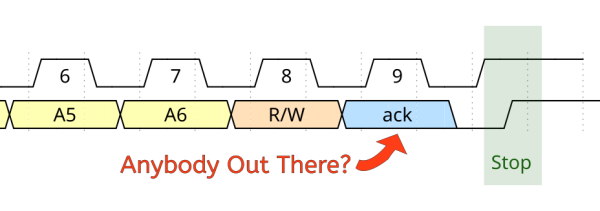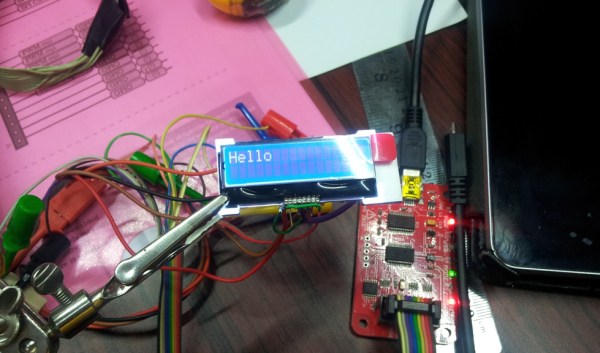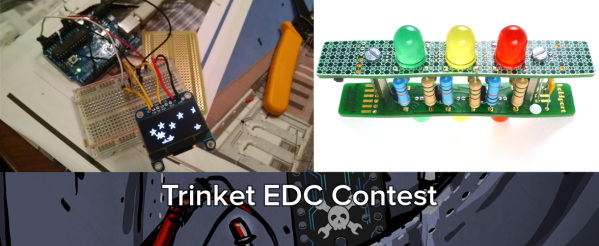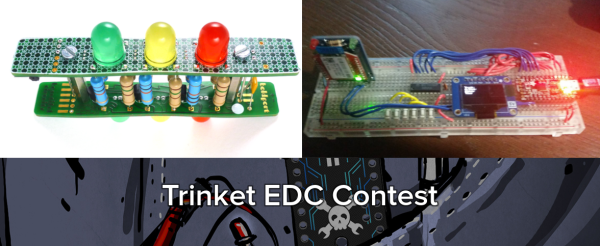A lot of great ICs use I2C to communicate, but debugging a non-working I2C setup can be opaque, especially if you’re just getting started with the protocol/bus. An I2C bus scanner can be a helpful first step in debugging an I2C system. Are all the devices that I think should be present actually there and responding? Do they all work at the bus speed that I’m trying to run? If you’ve got an Arduino or Bus Pirate sitting around, you’re only seconds away from scanning your I2C bus, and answering these questions.
bus pirate62 Articles
Caption CERN Contest – Not Your Father’s POV Display
Accidents happen – but the awesome quotes you all sent in for Week 15 of the Caption CERN Contest were no accident. A huge thank you for our biggest week yet! The scientists in this week’s image are definitely cleaning up after some type of nasty accident. At first blush it looks like an electrical problem in the coils of what appears to be part of a beam line. With all that soot and radiation dangers to boot, only the photographer and the people in the image know for sure!
The Funnies:
- “This is the second server these idiots have fried! What the hell’s a Hulu, and why are they trying to watch Gilligan’s Island with it?” Thanks to some unplanned quantum tunneling, Berners-Lee was even further ahead of his time than he thought” – [The Green Gentleman] (Two weeks in a row!)
- “I found the bug. Who gets to tell Joe he’s sterile?”- [jonsmirl]
- “‘I told the Captain that she couldn’t take any more’ – Scotty” – [md_reeves]
The winner for this week is [Mr. mmWave] himself, [Tony Long] with “Hardware Accelerator moto – Fail Fast, Fail Often. Also applies to Accelerator Hardware.” [Tony] will be debugging his next microwave mm band ham radio with a Logic Pirate From The Hackaday Store! Congratulations [Tony]!
Week 16: This is not your father’s POV Display!
 Scientists at CERN have come up with some amazing science advancements. They’ve also needed ways to display the data they collect. This image may depict some incredible new way to display data collected from a high power physics experiment – or it could be a scientist’s project for the CERN science fair. We may never know.
Scientists at CERN have come up with some amazing science advancements. They’ve also needed ways to display the data they collect. This image may depict some incredible new way to display data collected from a high power physics experiment – or it could be a scientist’s project for the CERN science fair. We may never know.
The album is titled CHAMBRE A ETINCELLES DANS EXPO TECHNOL, which roughly translates to “Sparks in the technology expo room”. The lines traveling between the three horizontal display devices definitely appear to be aligned. Are they sparks of electricity? You tell us!
 Last week’s prize was a Logic Pirate. This week we’re giving away a Bus Pirate from The Hackaday Store.
Last week’s prize was a Logic Pirate. This week we’re giving away a Bus Pirate from The Hackaday Store.
Add your humorous caption as a comment to this project log. Make sure you’re commenting on this contest log, not on the contest itself.
As always, if you actually have information about the image or the people in it, let CERN know on the original image discussion page.
Good Luck!
CAPTION CERN CONTEST – Accidents Happen
Week 14’s image may have had us at a loss for words, but it definitely didn’t slow down the intrepid caption contest entrants on Hackaday.io! Thanks to everyone who entered. We still have no idea what that device is, though we are sure that we wouldn’t want to be standing under it. Just look at those 4×4 sections of lumber holding everything up. What’s the French translation for “sketchy as hell”? The device definitely includes a pressure or vacuum vessel of some sort. Beyond that, your guess is as good as ours. We’ll keep an eye on CERN’s image discussion page in case an answer does pop up.
The Funnies:
- “Damn it Athol, stop harping about protocol and hand me the duck tape. This is nuclear physics, not rocket science!” – [The Green Gentleman]
- “This will mix a mean Margarita for the party tomorrow, I promise you!.”- [Mats L]
- “To long have we tried to smash particles, now we will blend them.” – [paul]
The winner for this week is [LongHairedHacker] with: “After weeks of complicated assembly the team finally found out that the IKEA Årc, was in fact not a fusion reactor. It did make a hell of an espresso though.”
As promised, [LongHairedHacker] will be taking home a Bus Pirate From The Hackaday Store!Congratulations!
Week 15
 Accidents happen! When you’re working on the bleeding edge of science and technology, things don’t always go as planned. In this image, we’re looking at what appears to be the result of some sort of failure. We’re not sure what the piece of equipment was, but “was” is the proper term – as it’s now charred to a crisp.
Accidents happen! When you’re working on the bleeding edge of science and technology, things don’t always go as planned. In this image, we’re looking at what appears to be the result of some sort of failure. We’re not sure what the piece of equipment was, but “was” is the proper term – as it’s now charred to a crisp.
The two scientists investigating the damage don’t seem to be worried about the radiation warning posted on the end of the machine’s aperture. Hopefully they know what they’re doing!
Last week’s prize was a Bus Pirate. This week we’re giving away another Dangerous Prototypes design, a Logic Pirate from The Hackaday Store.
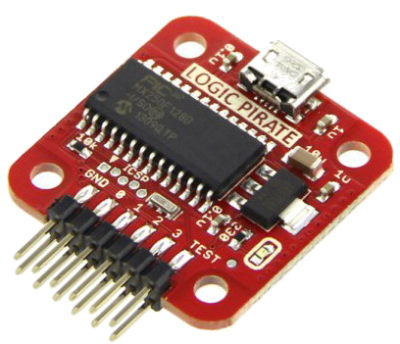
Add your humorous caption as a comment to this project log. Make sure you’re commenting on the contest log, not on the contest itself.
As always, if you actually have information about the image or the people in it, let CERN know on the original image discussion page.
Good Luck!
Learning I2C With The Bus Pirate
When an air quality display project needed a display, [Inderpreet] looked into small character-based LCDs. [Inderpreet’s] chosen LCD used an I2C interface, which was new to him. Rather than shy away, [Inderpreet] grabbed his Bus Pirate and dove in!
I2C or Inter-Integrated Circuit serial interfaces are often mentioned here on Hackaday. They generally are easy to use, but as with all things, there are little gotchas which can make the road a bit more bumpy the first time you travel it. One of those things is voltage interfacing – I2C uses bidirectional open drain lines, so interfacing 3.3 V and 5V circuits requires a voltage level shifter circuit designed to handle that requirement. Thankfully in [Inderpreet’s] case, both his TI launchpad target devboard and the LCD used 3.3 volt logic levels.
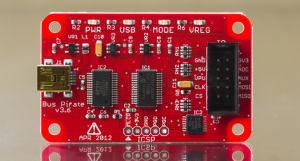 Before using the TI though, [Inderpreet] wanted to test with the Bus Pirate first. This would allow him to verify the hardware, and to make sure he was correctly using the I2C bus. The Bus Pirate can operate at 3.3V or 5V logic levels, and has on-board programming specific to the I2C bus. Controlling the Bus Pirate is as easy as hooking up a serial terminal program and plugging in a USB cable.
Before using the TI though, [Inderpreet] wanted to test with the Bus Pirate first. This would allow him to verify the hardware, and to make sure he was correctly using the I2C bus. The Bus Pirate can operate at 3.3V or 5V logic levels, and has on-board programming specific to the I2C bus. Controlling the Bus Pirate is as easy as hooking up a serial terminal program and plugging in a USB cable.
The I2C bus protocol is relatively simple, but can still be confusing to a new user. Each transaction needs an address, read/write bit, and a start command sent in the proper sequence before the data bytes can begin flowing. There are also acknowledge bits which prove that the data bytes are actually being received by the LCD. The Bus Pirate made all this easy, allowing [Inderpreet] to quickly display “Hello” on his LCD module.
The I2C bus is just the tip of the iceberg for the Bus Pirate. If you’re interested in learning more, check it out over at The Hackaday Store!
[via Dangerous Prototypes]
TRINKET EDC CONTEST DRAWING #4 RESULTS
The fourth of five random drawings for Hackaday’s Trinket Everyday Carry Contest was held tonight. The winner is [davish] with his entry, Trinket Watch.
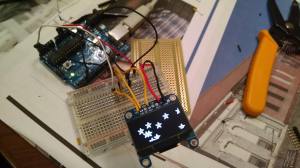 [davish] loves the current crop of smartwatches, but he wants one he can truly call his own. He’s using the Pro Trinket along with an Adafruit 1.3″ OLED for display duties. That little OLED can show a lot more than just numbers though. [davish] already has Adafruit’s logo demo running on the device. Trinket Watch is going to start out as a simple Arduino coded “dumbwatch”. After the basics of time and date are out of the way, [davish] hopes to add a Bluetooth module and turn Trinket Watch into a full-fledged smartwatch.
[davish] loves the current crop of smartwatches, but he wants one he can truly call his own. He’s using the Pro Trinket along with an Adafruit 1.3″ OLED for display duties. That little OLED can show a lot more than just numbers though. [davish] already has Adafruit’s logo demo running on the device. Trinket Watch is going to start out as a simple Arduino coded “dumbwatch”. After the basics of time and date are out of the way, [davish] hopes to add a Bluetooth module and turn Trinket Watch into a full-fledged smartwatch.
 We hope [davish] enjoys his new Cordwood Puzzle from The Hackaday Store. No jigsaws here, cordwood is a puzzle that involves solder! If you get a piece wrong, it’s time to break out that solder wick and fix your mistake. The puzzle is built using the cordwood assembly technique which was popular in the 1950’s and 1960s. We’re not kidding about it being a puzzle either – there are no instructions for this kit! [davish] will know he’s got it right when all 3 LEDs light up.
We hope [davish] enjoys his new Cordwood Puzzle from The Hackaday Store. No jigsaws here, cordwood is a puzzle that involves solder! If you get a piece wrong, it’s time to break out that solder wick and fix your mistake. The puzzle is built using the cordwood assembly technique which was popular in the 1950’s and 1960s. We’re not kidding about it being a puzzle either – there are no instructions for this kit! [davish] will know he’s got it right when all 3 LEDs light up.
 If you didn’t win this week, all is not lost, you still have one more chance to win a random drawing! Our next drawing will be on 12/30/2014 at 9pm EST. The prize will be a Teensy 3.1 and audio adapter as a prize. To be eligible you need to submit your project as an official entry and publish at least one project log during the week.
If you didn’t win this week, all is not lost, you still have one more chance to win a random drawing! Our next drawing will be on 12/30/2014 at 9pm EST. The prize will be a Teensy 3.1 and audio adapter as a prize. To be eligible you need to submit your project as an official entry and publish at least one project log during the week.
The main contest entry window closes on January 2, 2015 – but don’t wait for the last minute! Hit the contest page and build some awesome wearable or pocketable electronics!
Trinket EDC Contest Drawing #3 Results
We’ve held our third drawing for the Trinket Everyday Carry Contest. Once again we’ve used a Pro Trinket to pick the random winner. This week’s winner is [Scissorfeind] with his project Stylin’ safety jacket
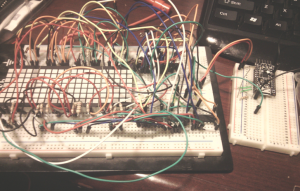 In true hack style, [Scissorfeind] went into this project with two goals: A jacket that will be visible at night, and keep him “looking f*cking sick”. The jacket itself is a faux leather affair from a thrift store. [Scissorfeind] added some studs for bling, and he’s working on adding a ton of electronics for light.
In true hack style, [Scissorfeind] went into this project with two goals: A jacket that will be visible at night, and keep him “looking f*cking sick”. The jacket itself is a faux leather affair from a thrift store. [Scissorfeind] added some studs for bling, and he’s working on adding a ton of electronics for light.
The Pro Trinket will be driving a series of LED matrices, which [Scissorfeind] is working on turning into POV displays. The matrices come from an LED clock which [Scissorfeind] saved from the landfill. In fact, most of the parts in the jacket are upcycled from e-waste. The jacket is just starting to come together. We can’t wait to see the final results!

We hope that [Scissorfeind] enjoys his Bus Pirate V3.6 from The Hackaday Store. The Bus Pirate was designed by former Hackaday writer [Ian Lesnet] as a Swiss Army knife of electronic communications. If you’re trying to connect to a circuit with SPI, I²C, JTAG, or UART, the Bus Pirate has you covered. It can do plenty more though – from reading analog data to programming components. Check out [Brian Benchoff’s] full review on the Bus Pirate V3.6 product page!
 If the pseudo random number gods didn’t smile on you this week, don’t worry, there are still two more chances to win a random drawing! Our next drawing will be on 12/23/2014 at 9pm EST. The prize will once again be a Cordwood Puzzle! To be eligible you need to submit your project as an official entry and publish at least one project log during the week.
If the pseudo random number gods didn’t smile on you this week, don’t worry, there are still two more chances to win a random drawing! Our next drawing will be on 12/23/2014 at 9pm EST. The prize will once again be a Cordwood Puzzle! To be eligible you need to submit your project as an official entry and publish at least one project log during the week.
The main contest entry window closes on January 2, 2015 – but don’t wait for the last minute! Hit the contest page and build some awesome wearable or pocketable electronics!
Trinket Everyday Carry Contest Drawing #2 Results
We’ve held our second drawing for the Trinket Everyday Carry Contest. This week we used a Pro Trinket to pick the random winner. The winner is [mikeneiderhauser] with his project WorkoutAid!
 [Mike] loves hitting the gym, but hates pulling out his phone or fumbling with his headphones to change songs during his routine. WorkoutAid is designed to fix this problem. It’s essentially a Bluetooth media display and remote. Track metadata will be displayed on a 128×64 OLED. 6 buttons will allow the user to change tracks, volume, or perform other functions. The whole device will communicate with a custom Android application through an RN42X Bluetooth radio.
[Mike] loves hitting the gym, but hates pulling out his phone or fumbling with his headphones to change songs during his routine. WorkoutAid is designed to fix this problem. It’s essentially a Bluetooth media display and remote. Track metadata will be displayed on a 128×64 OLED. 6 buttons will allow the user to change tracks, volume, or perform other functions. The whole device will communicate with a custom Android application through an RN42X Bluetooth radio.
 We hope [Mike] enjoys his new Cordwood Puzzle from The Hackaday Store. No jigsaws here, cordwood is a puzzle that involves solder! It’s built using the cordwood assembly technique which was popular in the 1950’s and 1960s. We’re not kidding about it being a puzzle either – there are no instructions for this kit! [Mike] will know he’s got it right when all 3 LEDs light up.
We hope [Mike] enjoys his new Cordwood Puzzle from The Hackaday Store. No jigsaws here, cordwood is a puzzle that involves solder! It’s built using the cordwood assembly technique which was popular in the 1950’s and 1960s. We’re not kidding about it being a puzzle either – there are no instructions for this kit! [Mike] will know he’s got it right when all 3 LEDs light up.

If you didn’t win this week, don’t worry, there are still three more chances to win a random drawing! Our next drawing will be on 12/16/2014 at 9pm EST. The prize will be the ever handy Bus Pirate V3.6. To be eligible you need to submit your project as an official entry and publish at least one project log during the week.
The deadline for the big contest is January 2, 2014! More than 60 projects are entered so far, but only the top 50 will receive custom t-shirts. The top three projects will win some seriously awesome prizes, including a Rigol DS1054Z Oscilloscope, a Fluke 179 meter, and a Hakko/Panavise soldering bundle.
So what are you waiting for? Get off the couch and get hacking!

